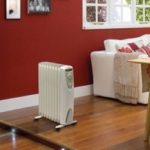Choosing an electric convector heating with thermostat
Electric convectors Heating with thermostat designed to maintain optimum temperature in the room. Convectors meet all modern requirements: they are environmentally friendly, safe, reliable and presented with a rich assortment of modifications and forms. The range of cost of such devices covers all price categories: cheap, medium, expensive. In short, each will select the appropriate model, whether it is a simple low-power convector or a multifunctional device with an individual design. Convectors are somewhat different from electric heat guns, oil heaters, infrared installationsand have some significant benefits.
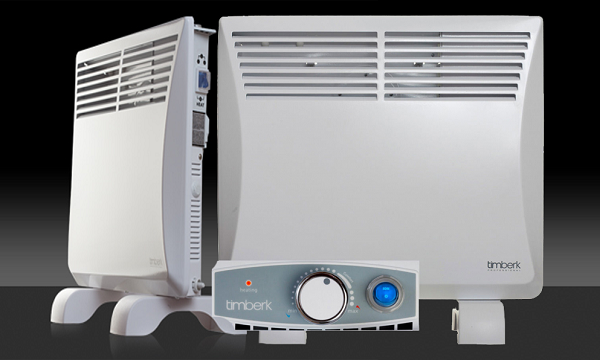
Content
Principle of operation of the device
The design of the appliance is quite simple: a heating element is built into the lower part of the metal case. The cold air enters the device from the bottom, warms and rises through the upper holes, which creates a natural circulation (convection) of air masses.
Unlike a heat gun or electric heater, the design of the convector, as a rule, does not provide for the installation of a fan (although there are models with built-in fanbecause it does not create any noise. This is very convenient - the device can be used around the clock, but you should pay attention to type of heating element.
There are three types of heating elements: needle - the cheapest and short-lived; tubular heating elements, which when heated emit characteristic clicks; The mololite elements are noiseless, but much more expensive.
Electroconvectors achieve relatively low temperatures during operation, so that the device does not overdry and does not burn airwhile maintaining a comfortable indoor environment.No additional installation required when using the convector. humidifier. This feature of the electric heater makes it environmentally friendly.
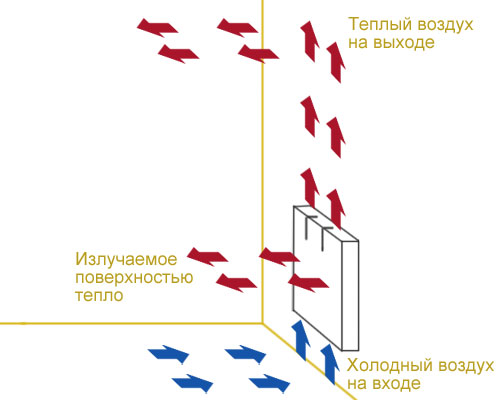
Temperature adjustment is carried out using a thermostat, which can be mechanical or electronic. All models imply the presence of a thermostat that responds to temperature changes and eliminates overheating. When the air entering from below heats up to the set limit, the heating element automatically shut off.
Types of electroconvectors
Electric convectors are fundamentally different from the usual radiators: they are much easier to install, more aesthetic and work according to another principle. Radiators heat the surrounding air due to the high temperature of their own body, and the electric convector provides natural air circulation.
Design is one of the distinguishing features of electric convectors.. Almost all models are made in a restrained hi-tech style, and are suitable for heating: apartments, villas, offices, work rooms, workshops. Many manufacturers are ready to put an image on the faceplate or trim it with naturala stone. The market offers a variety of modifications. convector heatersThis allows you to choose the most suitable model for any needs, taking into account the style of the interior.
There are models by type of installation:
- wall mounted;
- floor standing;
- universal;
- recessed.
Each category has its own advantages and disadvantages. In order to decide on the choice of model, it is necessary to evaluate everything.
Wall convectors
One of the most popular - wall models. They can rightly be called optimal for an apartment, cottage or office, especially if the area of the room is small. A wall mounted convector takes up minimal space due to the fact that the width of the devices is very modest.
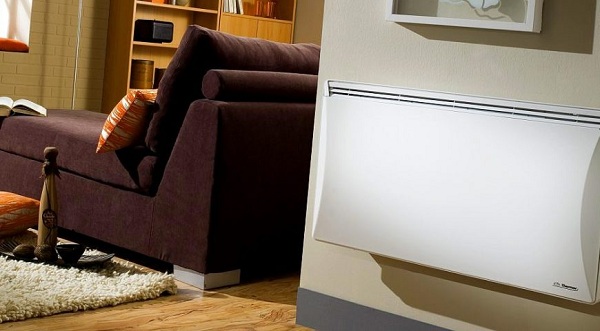
You can install the device yourself: just drill a few holes in the wall and fix the appliance. A set of fasteners does not always come as standard, installation is carried out on a conventional dowel plug 6 mm in diameter. If there is an empty space under the exterior trim of the wall, for example, when a wooden sheathing is made, it is drilled, deepening the screw into an array of wood, concrete or brick.Such a measure will exclude the fall of the device, the average weight of which is 6.5 kg.
Installation can be carried out in different ways, depending on the configuration of a particular model:
- on brackets fixed to the wall;
- on the brackets located on the device itself.
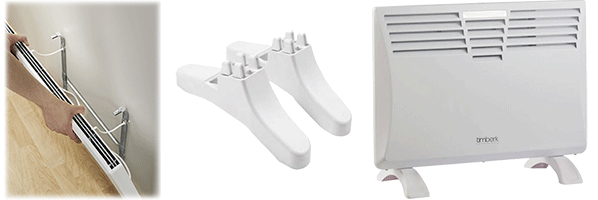
Universal called wall models, the configuration and design of which involves the installation of legs (often - with rollers) for placement on the floor. The key advantages are the high mobility of such an electric device: it can be mounted on the wall or mounted on the floor.
Floor and recessed convectors
Externally, floor models differ little from wall ones, with the exception of more solid legs or rollers. Install such convectors on the floor, in any part of the room, the minimum distance from the wall is 5 cm. Using mobile non-stationary convectors some inconveniences are not excluded, because they occupy the space of the room. At the same time, such a device can be freely moved or transported.
Embedded Convector heaters are installed in the floor (sometimes in the window sill) and close the special grill.The disadvantage of such convectors is that they can be installed only permanently, during the repair or dismantling of the floor. For this type of convectors, a niche is needed in the floor, at a depth of at least 25 cm. Most often, such convectors are used for heating shopping centers and large salons.
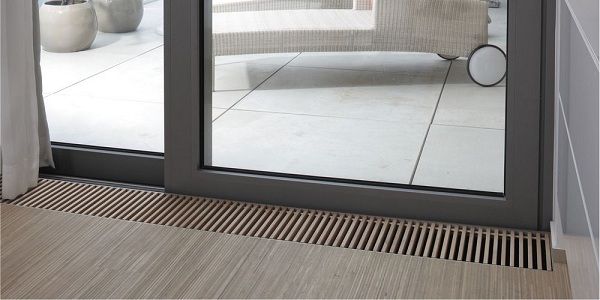
Built-in convector
Installation rules
The choice of a suitable place depends on the movement of air flow in the room. Optimally positioned convector under the windowswhere, as a rule, stationary radiators are installed. If the place is occupied, the device can be fixed on any wall, observing the basic rules:
- distance to the window sill of at least 12 cm;
- height from the floor of 10 cm;
- the distance from the wall (or furniture) to the device is from 5 cm.
As already mentioned, floor models can be placed anywhere, retreating 5 cm from walls, furniture and other surfaces that may impede the movement of air or deform. In addition, manufacturers do not recommend installing ceiling heater. Warm air, rising, will heat the device and the thermostat will turn off the heater, while at the bottom the air will be cool.
Safety
Buying a new convector, first of all, you need to check it in work. The technique may malfunction if errors (defect) occurred during assembly. A working electric heater should heat the air, automatically turn off and turn on when the temperature changes.
It is important to know! If the thermostat's relay does not work correctly, the device will continuously generate heat, as a result of which the heater may overheat and deform.
Prohibited cover the heating device, dry things or various items on it. In this case, the thermostat should operate and turn off the heating element, but in case of malfunctions or inaccurate operation of the thermostat, a fire may occur.
Advantages and disadvantages of electric convectors
Electroconvector is the best option for heating any room, both residential and non-residential. If you follow the safety rules, it is quite possible to leave such equipment unattended.
- Convectors are quite easy to install.
- There are many modifications in design, design and additional options.
- The thermostat allows you to optimally consume electricity.
- During operation, the device practically does not emit sounds.
- Protection against overheating allows you to mount the device on any surface.
- The outer panel of the heater has a relatively low temperature, about 40 ° - 60 °, in case of accidental contact with the device burns are excluded.
- An electric convector does not burn or dry the air, which is a significant advantage. The overdried air negatively affects the state of health; quite often the users of heat guns experience headaches after 3 to 4 hours of using the device (and gas or diesel heaters an order of magnitude more dangerous).
- The principle of operation involves the vertical movement of air masses, which eliminates the appearance of drafts and other horizontal air flows.
Additional options which convectors can possess:
- the possibility of choosing a suitable heating program with an electronic thermostat (economical, standard, individual, “comfort” and similar);
- protection against splashes (can be installed in rooms with high humidity);
- air ionization (even when the heating is turned off);
- frost protection when the device turns on automatically if the ambient temperature has dropped below 5 °;
- a tilt-responsive sensor automatically shuts down the device for safety reasons;
- the heat indicator will show if the convector is currently working;
- thermostat (can be electronic or mechanical);
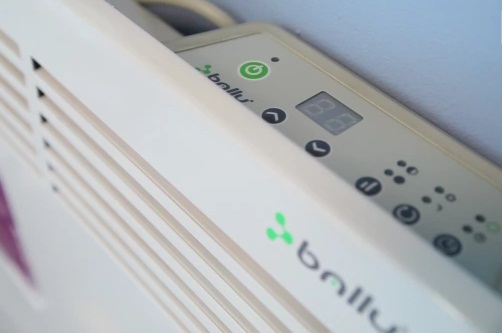
Convector with electronic thermostat
- Some models are equipped with the ability to "remember" the settings and play them automatically after switching off;
- the control module will allow the monitoring and control of several devices through a single remote control;
- programmable thermostat will allow you to set certain parameters of heating for time, dates, days of the week.
Electric heaters with thermostatic heating have some disadvantages. In most models, warm air moves vertically, so the room is heated from top to bottom. As a result, if there is no additional heating, the room will be warm up for a long time in winter. For example, a stall, a shopping box, a room in a private house without heating, a garage - in such rooms it is advisable to use a convector only in the casewhen the device is running continuously. Another disadvantage of the device is no fan. If electric guns and heaters can perform the function of a fan in the summer, the convector can only heat the air.
The cost of the convector is slightly higher than the usual heater, but this disadvantage is very doubtful, because it is compensated by significant advantages. It is worth noting and relatively high power consumption. The thermostat allows you to set a small power, for example - 650W, but this is not enough to warm the cold room (warehouse, garage). This economy mode is suitable for maintaining heat in a room where there is centralized (or additional) heating, but it is not enough to maintain a comfortable temperature.
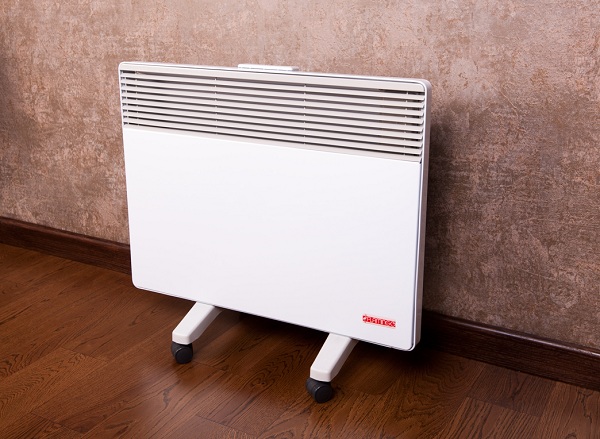
Mobile convector on the floor
What guide when choosing
The main criterion when choosing the optimal model is the power of the device. This indicator directly determines which quadrature is designed convector heater. To calculate the minimum power, it is customary to multiply the floor space by a factor of 0.1 (20 square meters * 0.1 = 2 kW).If the ceilings in the room above the standard 2.5 - 2.7 m, then the result, 2 kW, is additionally multiplied by 1.5, in the end it turns out 3 kW. In the presence of additional heating indicator of 2 kW multiplied by a factor of 0.5 (or 0.7, leaving power reserve), then the required power of the device will be in the range of 1 - 1.5 kW.
In practice, each situation must be considered individually, or to test equipment empirically by renting it at the rental center. The heating rate is influenced by various factors:
- outside air temperature;
- interior materials;
- the material from which the building is made (wood, concrete, brick).
The above formula is suitable for rooms without any heating and implies heating (up to 18-20 degrees) for 2 to 4 hours. When the convector serves as an additional source of heating, there is no need for a power reserve. In a residential apartment or a private house, 1–1.5 kW will be sufficient to maintain a comfortable temperature in rooms from 5 to 35 square meters.

/rating_off.png)






